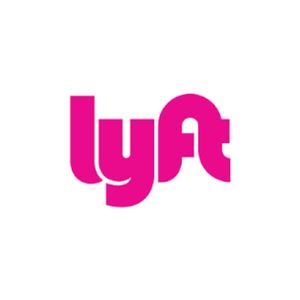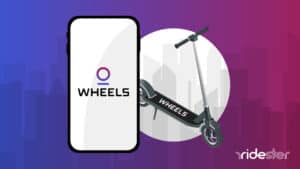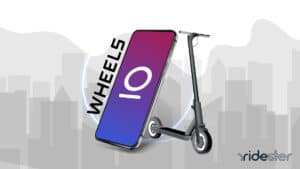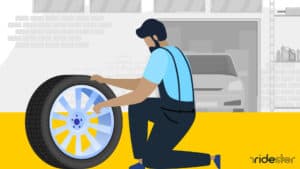Key Takeaways
- Lyft vehicle inspections ensure vehicles meet safety and operational standards.
- Inspections, required annually or biennially, check tires, brakes, lights, and more.
- Costs vary by location; Lyft Hubs offer free inspections, others charge $20-$50.
- Inspections are crucial for rider and driver safety, maintaining Lyft’s service quality.
What is a Lyft Vehicle Inspection & How Do They Work?
A Lyft vehicle inspection is a mandatory evaluation for Lyft drivers to ensure their vehicles meet established safety and operational standards. Conducted either annually or biennially depending on the location, these inspections assess various vehicle components, including tires, brakes, lights, and more.
Mechanics either at designated inspection centers or approved third-party facilities perform a thorough check. If a vehicle passes, it’s deemed fit for rideshare service; if not, necessary repairs must be made before re-inspection.
The Importance of Lyft Vehicle Inspections
Lyft vehicle inspections are an integral component in upholding the safety and trust of the ride-sharing ecosystem. These thorough checks are meticulously designed to ensure that each vehicle meets strict safety and quality standards.
By consistently enforcing these standards, Lyft guarantees that every ride is not only about convenience but also embodies a commitment to passenger and driver safety. This rigorous process bolsters confidence and trust among users, underpinning the platform’s reputation and reliability.
How Much Do Lyft Vehicle Inspections Cost?
The cost of a Lyft vehicle inspection can vary based on location and provider. Typically, you’ll see prices at or around these:
- Lyft Hub: Free, but availability is limited across the U.S. Some Hubs only offer re-inspections, excluding new drivers from free service.
- Jiffy Lube: $30-50, depending on location
- Rideshare Mechanic: $39.99
- Local Mechanic: Typically $20 to $30
Lyft Hubs, in-person driver support centers, are recommended for free inspections. For quicker service in many cities nationwide, Lyft collaborates with Jiffy Lube and Pep Boys. Sometimes they offer discounts, so always check local options for the best deal.
Sometimes the Price is Negotiable
I recently got my vehicle inspected at a local Jiffy Lube. While I was there, I had them run two inspections simultaneously – one for Uber and one for Lyft.
I was able to negotiate my price because of this, getting $10 off because of the efficiency. Additionally, I paid cash, so I saved another $3 per inspection.
Can I Get a Free Car Inspection?
Yes, you can get a free car inspection in cities that have Lyft Hubs. The Hub is an in-person support location for drivers to get help with issues they face working for Lyft.
If your city doesn’t have a Hub, you might be able to get a free inspection at an auto shop. Lyft partners with some shops to streamline the inspection process and make it free for drivers. You can find these shops in the Lyft Driver app.
On the vehicle inspection menu, you’ll see an option to schedule an inspection and can book the appointment through the app. Some shops also offer free re-inspections.
If you’ve already passed the inspection, you can get a free updated inspection. The shop knows your vehicle already meets the baseline requirements, so there’s less work for them to do. If you’ve never had your car pass a Lyft inspection, you can’t take advantage of this option.
Finding Locations and Scheduling a Lyft Inspection:
Lyft has made finding vehicle inspections very simple and streamlined from within the Driver app.
First, open the Lyft driver app, then navigate to the “Vehicle” section. If you need an inspection, the app will display a prompt that indicates that you are missing a document.
In my case, since I hadn’t driven in a while, the system gave me this warning.
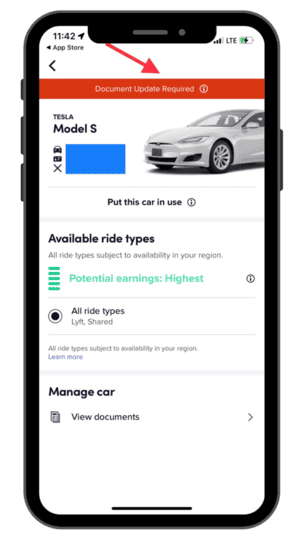
Simply click the red indicator message and a box should pop up.
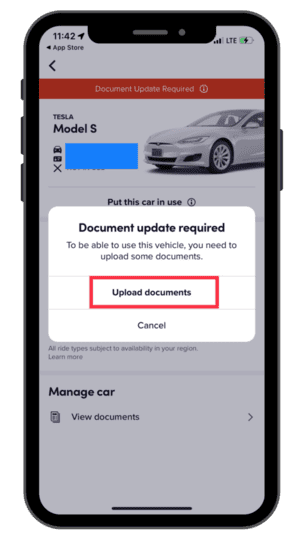
From there, the system will tell you what you need to upload. I tapped Rideshare vehicle inspection.
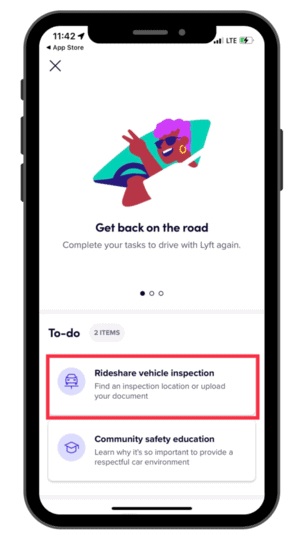
There are two options here: finding an inspection and uploading a form. Since I needed to find a location, that is the option I selected.
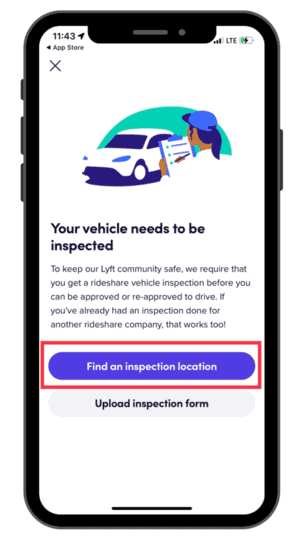
Once tapped, you will see a large list of locations that offer inspections.
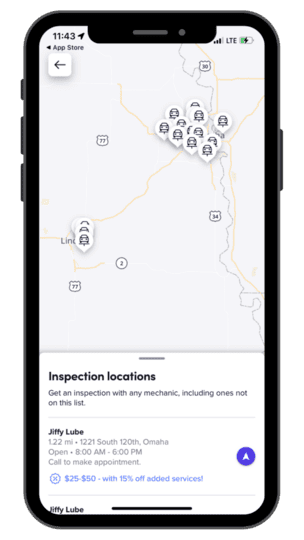
Navigating to any one of them will show you site-specific information about the location. This includes an estimated cost range, hours, location (with directions) and a button to call the location.

Some locations might allow you to schedule an appointment directly through the app. Since I used Jiffy Lube, I had to manually call and set an appointment.
Preparing For Your Inspection
Since you know what the inspection is looking for, there is really no reason to fail. Doing some legwork up front maximizes your time when you get to the inspection.
Some common steps you can take include self-checking:
- Lights and Signals: Before you head to the inspection center, ensure all headlights, tail lights, brake lights, and turn signals are fully operational. Flick each switch, step on the brakes, and ensure everything illuminates as it should.
- Tire Check: Examine your tires for any visible signs of wear or damage. Also, invest in a simple tire pressure gauge. Ensuring your tires are properly inflated not only helps with the inspection but also improves fuel efficiency.
- Windshield and Wipers: Look over your windshield for any cracks or chips. Test your wipers in both rain and dry conditions to ensure they clear the windshield effectively without leaving streaks.
- Brakes: Pay attention to any unusual noises when you apply the brakes. If your brake pedal feels soft or spongy, it might be time for a checkup before the inspection.
- Fluid Levels: From brake fluid to windshield wiper fluid, ensure all are topped up and there aren’t any leaks.
- Seat Belts: Check each seat belt’s function, ensuring they latch and retract smoothly.
Again, do the work up front so that you can breeze through the inspection when you’re there. If you fail, you’ll have to pay for two inspections – the failed one, and then another return trip.
What to Expect During the Inspection
The actual process of getting a vehicle inspection is incredibly simple. I simply showed up, walked in and let them know that I had just called. Somebody immediately came out to my vehicle with a piece of paper and a clipboard and started inspecting my car.
The list of inspection points is exactly what you’d expect when checking the safety of a vehicle. Common issues like brakes, tires, headlights, doors, and seat belts were checked.
We’ve made a PDF copy of the Lyft vehicle inspection form available using this link: DOWNLOAD INSPECTION FORM.
Here’s a list nearly identical to the one the technician cross-referenced my vehicle against:
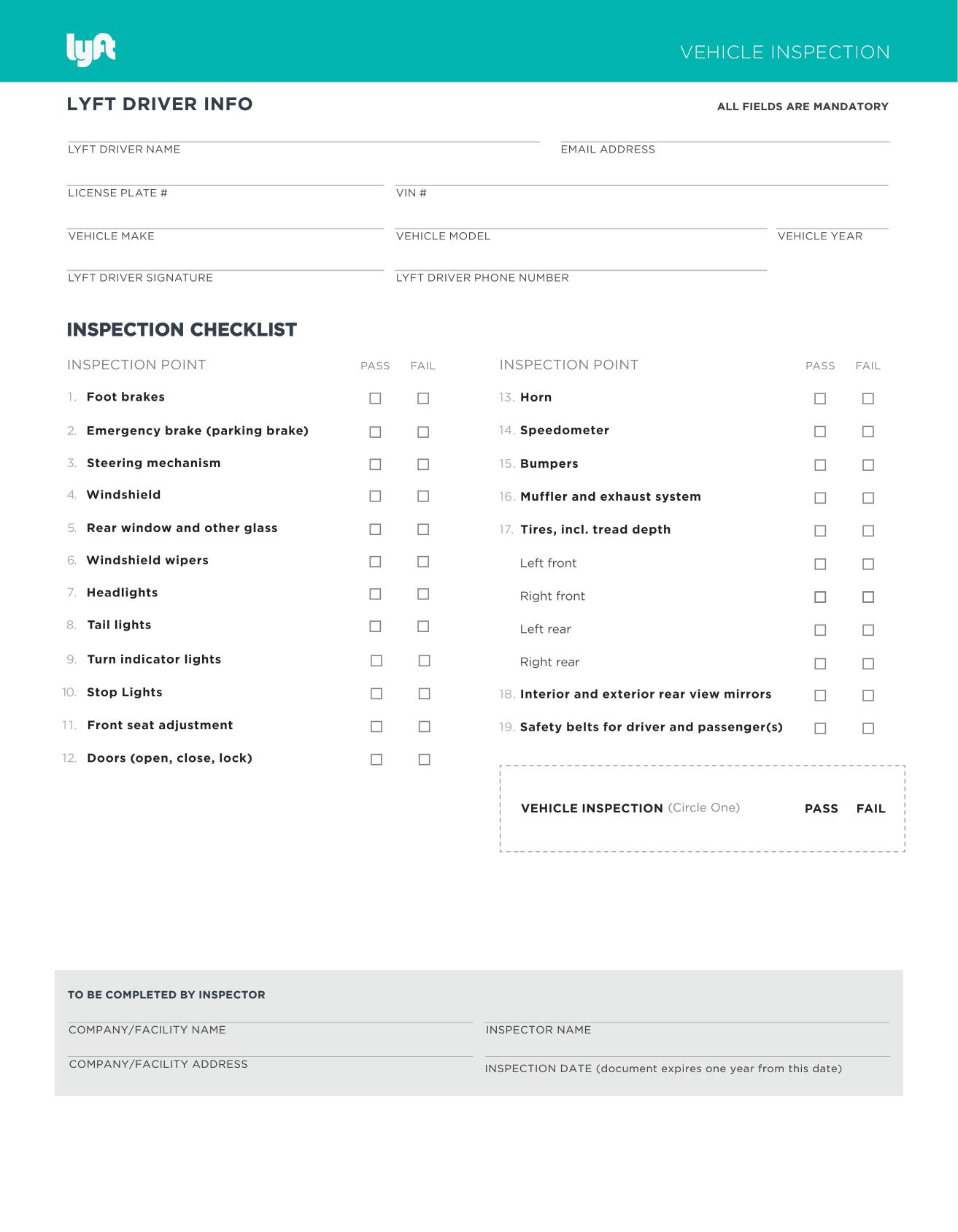
All in all, I was there for roughly 30 minutes. After I paid in cash, I was on my way.
What Can Cause a Car to Fail a Lyft Vehicle Inspection?
If an aspect of your car isn’t safe, you’ll fail the vehicle inspection. You need good tire tread, responsive brakes and steering, and all the requirements listed above.
In general, Lyft doesn’t care too much about the look of your car unless you’re driving for Lyft Lux. They care more about how well your car drives because they value all drivers’ and passengers’ safety.
However, some cosmetic damage can disqualify your vehicle. Lyft doesn’t want its name on beat-up cars. Dents or scratches larger than a baseball might eliminate your car.
They also won’t approve cars that have mismatched panels. This might sound superficial, but the mismatched panels mean the car has sustained damage and repairs, making it less safe for drivers and passengers.
What Do You Do if You Fail a Lyft Inspection?
Don’t worry if your vehicle fails its inspection. Simply follow these instructions.
- Step one: Make an inspection appointment with an auto repair shop
- Step two: Take your vehicle to the mechanic
- Step three: Wait for the mechanic to make the necessary repairs
- Step four: Return to the location where you completed the initial inspection
- Step five: Pass the second Lyft inspection
Uploading a Lyft Vehicle Inspection Form
Follow the steps you previously look above. Head to your account, tap Your Vehicles, and then open the vehicle you’re uploading an inspection for.
This time, select the “upload photo” option, and you’ll be able to upload your inspection to the Lyft driver app.
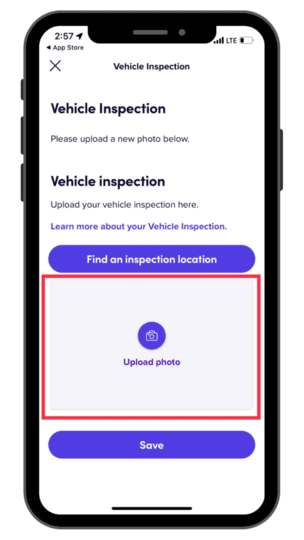
Once the system uploads your inspection, you’ll probably have to wait a few hours for it to get approved. In my case, this process took less than 30 minutes, and then my account was ready to go.
Frequently Asked Questions
You may still have questions about the Lyft vehicle inspection. Here are the answers to three commonly asked questions.
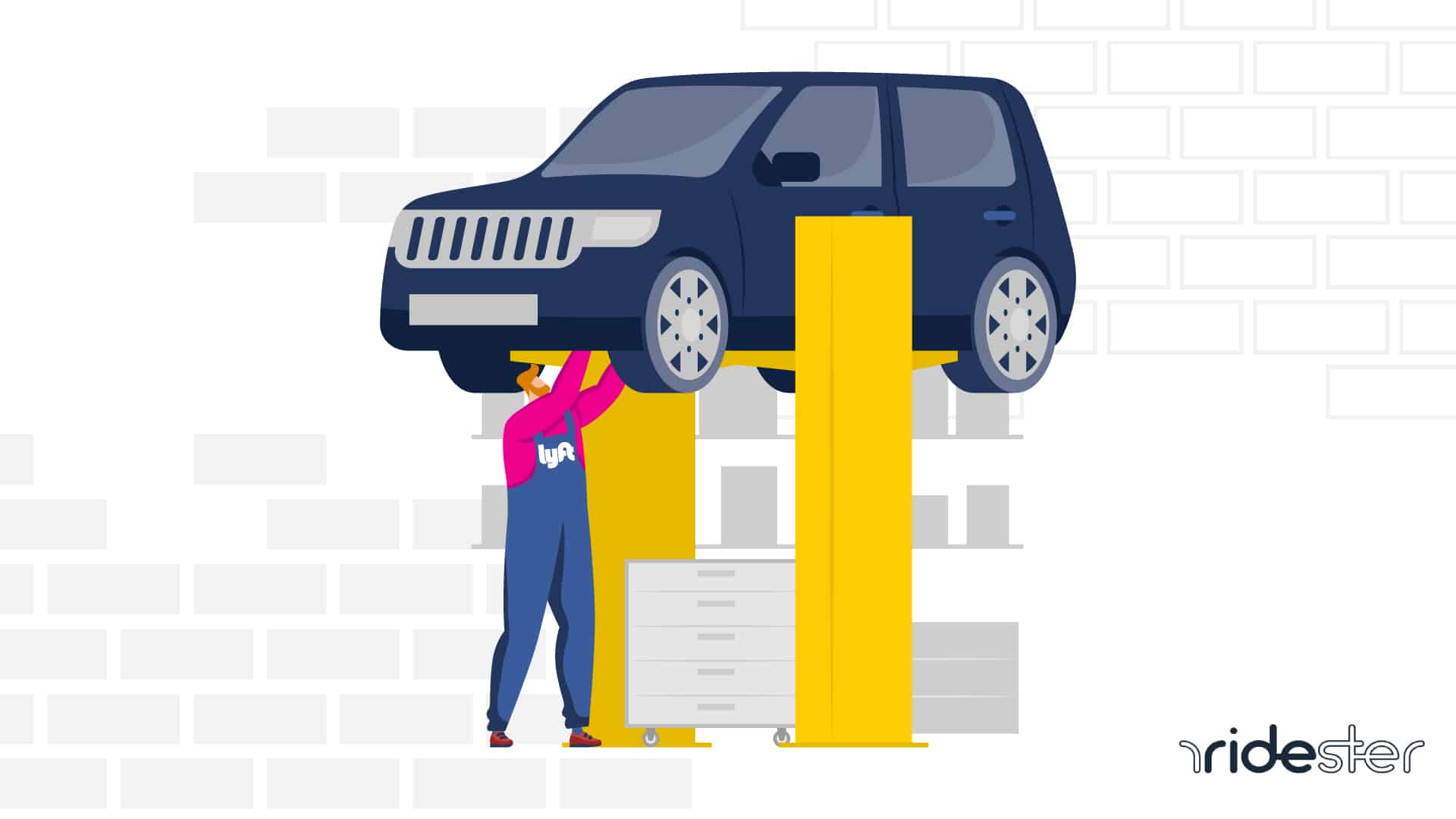
Is the Lyft vehicle inspection the same for all ride types?
Yes. Drivers for all services need to complete the same Lyft inspection process. If you’re planning to drive for multiple Lyft services, there is no need to go through multiple inspections.
Can I use my Uber vehicle inspection form to get approved for Lyft?
While it was once easy to use Uber vehicle inspection forms on Lyft (and vice versa), there’s no longer a guarantee that Lyft will accept your completed Uber forms.
This is especially the case if you get your inspection done at an Uber Greenlight Hub, where team members will only complete Uber-branded forms and, in some states, may follow slightly different processes than Lyft.
A great workaround to save time and avoid paying double the cost is heading to a third-party mechanic that’s approved by both companies.
When you do so, your mechanic can simply fill out both forms in one go, so you can get approved as a Lyft and Uber driver without two separate visits.
Are Lyft vehicle inspections tax deductible?
Yes, the vehicle inspection is a tax deduction. It’s a vehicle-related expense, similar to when you deduct gas, mileage, and repairs. If you can’t find a Lyft Hub for a free inspection, save the receipt from your local mechanic or Rideshare Mechanic.



